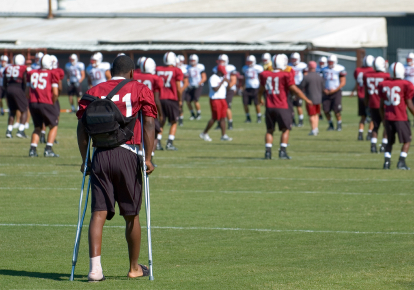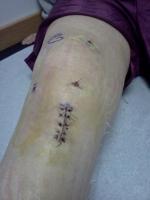Sports Injury Treatment Basics
Sports injury treatment is the first phase in the recovery process. It deals with the initial management of the injury, and sets the stage for successful rehabilitation and return to sports activities. Proper treatment can literally cut weeks off of your total recovery time.
The primary goal of any treatment program should always center around controlling the initial pain, inflammation, and dysfunction caused by the sports injury. Your body goes through specific physiologic processes for healing, and these processes need to be controlled and facilitated for optimal healing.
The most common problems that occur after injury are pain, swelling, loss of mobility, and loss of strength. In addition to the actual tissue damage, we must also worry about controlling swelling and pain. Treatment will vary for different types of injuries, but there are several basic concepts that always apply. Once the initial injury is controlled, then you can progress on to sports injury rehab.
Evaluation, Examination, and Diagnosis
While initial treatment is important and should be done with any sports injury, it is just as important that you get an evaluation and diagnosis of your injury from a licensed healthcare provider. I strongly recommend seeing a physician, athletic trainer, or physical therapist who has experience with sports injuries. The treatments listed below can help with your initial recovery, but it is very important that you know what kind of injury you have so that you can know how best to treat it successfully.
An examination and diagnosis is also important to rule out serious problems such as fractures or ligament ruptures. What may look like an ankle sprain may actually be an ankle fracture - the treatments for these two injuries are very different, and the only way to know for sure what your injury is is to be evaluated by someone who is trained in diagnosis of sports injuries. For the best recovery possible, go see your healthcare provider.
Treatment Goals
When injury occurs, your body goes through very specific processes to begin healing. The first phase of healing is inflammation, and includes changes at the vascular and cellular level at the injury site. The signs and symptoms of inflammation include swelling, pain, muscular spasm, redness, increased temperature, and dysfunction. Swelling and pain are the most problematic symptoms of inflammation, so most sports injury treatments focus on reducing both.
You are probably already familiar with the most common approach to sports injury treatment - R.I.C.E., which stands for Rest, Ice, Compression, and Elevation. Each of these steps helps to control inflammation, and to aid in your overall recovery.
In addition to R.I.C.E., other treatments include protecting the injured body part through braces, limiting movements, crutches (for lower extremity injuries), and anti-inflammatory medications. These treatments help to control swelling and pain, and allow the body to go through the specific processes necessary for healing. It is important to remember that there is no way to SPEED UP the healing process. But there are a lot of things that you can do to slow it down. The ultimate goal of sports injury treatment is to facilitate the healing process without slowing it down.
- R.I.C.E
- The First Steps in Sports Injury Treatment
Rest, ice, compression, and elevation are the essential first steps in treating injury. Successfully using these steps immediately after an injury can cut your overall recovery time down significantly. Learn more about how to apply R.I.C.E., and why it works.
- Treating
Swelling
Swelling is a major problem, and contributes to most injury symptoms. Excessive swelling increases pain, limits range of motion, inhibits muscle contraction, and can lead to systemic inflammation and infection if not treated. Learn how to control initial swelling, and treatments to facilitate healing.
- Ice
Packs - Frozen Peas Anyone?
Cold treatments are a mainstay in sports medicine. Ice is one of the R.I.C.E. steps, and there are many ways to apply cold treatments. Learn more about ice packs for sports injury treatment, and how to create your own, or pick the best for your injury. - Sports Injury Treatment: Ice
Massage
This is a quick and easy way to apply ice therapy for injuries like shin splints, plantar fasciitis, and other muscle strains. Learn how to create your own ice massage cups, and how to use this cold treatment for your sports injury.
Treatments for Specific Conditions
- Ankle
Sprain Treatment
All the keys to treating an ankle sprain. It includes specific application of the R.I.C.E. principles, guidelines for when to get an X-ray or see your physician, and information about long-term care. - Ankle
Sprain Solutions
The first 'Solution Series' ebook, this downloadable program details all of the information you need to know about your ankle sprain. It includes information on ankle anatomy, common signs and symptoms of ankle sprains, initial treatment guidelines, and a comprehensive rehabilitation program to aid in your recovery. - Broken
Ankle Advice
Ankle fractures are common, both in sports and recreational activities. Learn more about this injury, and the treatments for acute and long term care.
- Meniscus
Tear Treatment
Learn more about the common signs and symptoms of a meniscus tear, and the treatment and rehabilitation guidelines for successful recovery.
- ACL
Knee Injury Treatment
ACL injuries require both initial treatment, as well as extensive rehabilitation following the injury or after surgical reconstruction. Learn more about treating ACL injuries, including information on common sign/symptoms, initial treatment, surgery, and rehabilitation. - Knee
Braces
Some knee injuries benefit from bracing to protect the injured, healing tissues. Learn more about the different types of knee braces and the injuries they are used for.
SII › Sports Injury Treatment

